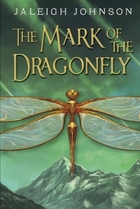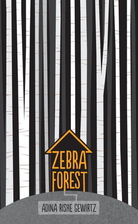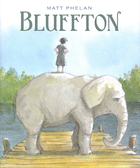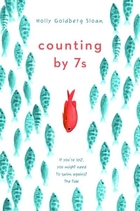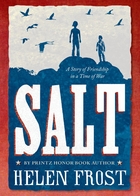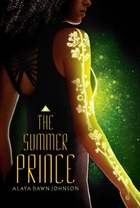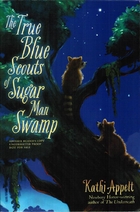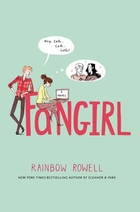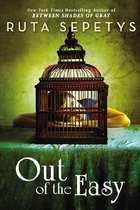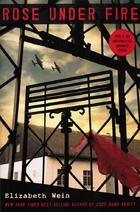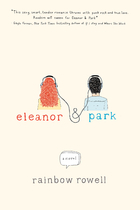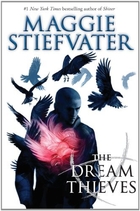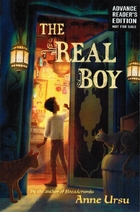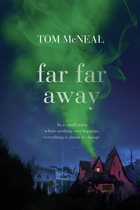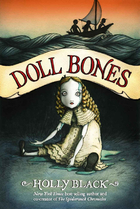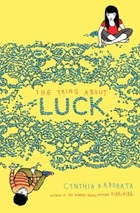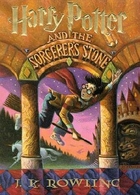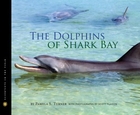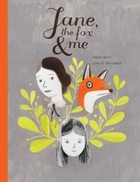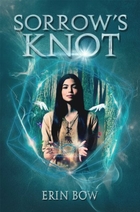The Mark of the Dragonfly by Jaleigh Johnson is a fantasy story with steampunk elements, for young teens or tweens.
Piper
is a young scavenger and machinist, with an uncanny skill with
machines. In Piper's world, frequent meteor showers bring fragments of
other-world technology hurtling to the ground, accompanied by a
poisonous dust. When the dust clears, scrappers like Piper rush to
snatch up the fragments, and occasionally something that they find can
be repaired and sold for a profit. Since her father died, Piper dreams
of escaping the scrap towns and finding a better job as a machinist in a
big city, but she knows that escape will take more money than she is
ever likely to see. Then, one night, one of Piper's friends foolishly
ventures out during a meteor shower, and Piper goes after him. Out in
the meteor fields, Piper is amazed to see a caravan coming through,
despite the danger. When the caravan is hit by a huge meteor, Piper's
friend is injured. Piper rushes to the remains of the caravan, hoping to
find medical supplies. What she finds there is a girl of about her own
age, alive but unconscious. Piper manages to drag both her friend and
the mysterious girl back to her home -- but when a menacing stranger
comes looking for the girl, Piper makes a split-second decision to run.
The girl, named, Anna, bears the mark of the dragonfly, granting her the
same level of protection as members of the king's household. Piper
assumes that she will be handsomely rewarded if she can return Anna to
her family. The two girls stow away on the 401, a steam engine that
carries supplies through the scrap towns to the capital city. But the
401 is guarded by Gee, a boy with mysterious powers -- and the journey
will be more dangerous than any of them could have imagined.
This
was a good story, but not a great one. I think that its target audience
of tweens and young teens will enjoy the friendships that grow between
the characters, as well as the fantasy and steampunk elements. I found
that there were a few holes in the worldbuilding that distracted me from
fully enjoying the story, but perhaps the things that bothered me will
be more fully explained in future volumes, as I am fairly sure that this
is intended as the first book in a series.
(Reviewed from an advance copy, courtesy of the publisher)
Wednesday, January 29, 2014
Thursday, January 23, 2014
Zebra Forest by Adina Rishe Gewirtz
Zebra Forest by Adina Rishe Gewirtz is a middle-grade novel set is small-town America during the Iranian hostage crisis.
Annie and her brother Rew live with their gran outside of town, near a forest of birch and oak trees that they call the zebra forest. Both of their parents are gone -- their mother left them when Annie was three years old, and their father is dead, killed in a fight with an angry man, as their gran has told them. One summer day, a man runs out of the forest and into their house. He says he will not hurt anyone as long as they do what he says. The man is an escaped convict from the nearby prison, and Annie and her family are suddenly hostages in their own home. Even more shocking is the realization that Gran knows the man: he is Annie and Rew's father, the angry man, not the man who was killed. Rew is furious with everyone, Gran descends into a deep, silent depression, but Annie can't help being a little curious. After all, she's spent her whole life wondering what her father was like.
This book does an excellent job of creating and sustaining mood and tension. Setting it during the Iranian hostage crisis worked thematically, though it was not necessary to the story other than that. I felt the characterization was a little uneven and the plot relied too much on a few big coincidences, but for a first novel, I found the book as a whole impressive.
(Reviewed from a copy borrowed through my library system.)
Annie and her brother Rew live with their gran outside of town, near a forest of birch and oak trees that they call the zebra forest. Both of their parents are gone -- their mother left them when Annie was three years old, and their father is dead, killed in a fight with an angry man, as their gran has told them. One summer day, a man runs out of the forest and into their house. He says he will not hurt anyone as long as they do what he says. The man is an escaped convict from the nearby prison, and Annie and her family are suddenly hostages in their own home. Even more shocking is the realization that Gran knows the man: he is Annie and Rew's father, the angry man, not the man who was killed. Rew is furious with everyone, Gran descends into a deep, silent depression, but Annie can't help being a little curious. After all, she's spent her whole life wondering what her father was like.
This book does an excellent job of creating and sustaining mood and tension. Setting it during the Iranian hostage crisis worked thematically, though it was not necessary to the story other than that. I felt the characterization was a little uneven and the plot relied too much on a few big coincidences, but for a first novel, I found the book as a whole impressive.
(Reviewed from a copy borrowed through my library system.)
Tuesday, January 21, 2014
Bluffton by Matt Phelan
Bluffton: My Summers with Buster Keaton by Matt Phelan is a juvenile graphic novel with a soft-focus, nostalgic feel.
In the early 1900s, summers are quiet in Muskegon, Michigan -- until the year a troupe of vaudeville performers come to spend a summer by the lake. Henry, a boy from Muskegon, quickly befriends Buster Keaton, a child star right around his own age. The boys bond over baseball, fishing, and just goofing off, and Henry soon finds himself envying Buster's glamorous life on stage. Will Henry be stuck in Muskegon forever?
This graphic novel is a treat to read -- Phelan's illustrations are lovely, and the text works with the images to convey Henry's longing for the big time . . . as well as certain things Buster might long for, but never expresses to his friend. I also admire how Phelan shifts near the end of the book from focusing on what happens during the summer and sliding through the winter with a series of wordless frames, to focusing on what happens in the winter, as Henry starts to see the potential in his own life. I enjoyed this book very much, though I'm not sure how much kid appeal it has -- quiet, thoughtful graphic novels don't leap off the shelf at my library, but I'm hoping it finds other readers who, like me, will appreciate its many fine qualities.
(Reviewed from a copy borrowed through my library system.)
In the early 1900s, summers are quiet in Muskegon, Michigan -- until the year a troupe of vaudeville performers come to spend a summer by the lake. Henry, a boy from Muskegon, quickly befriends Buster Keaton, a child star right around his own age. The boys bond over baseball, fishing, and just goofing off, and Henry soon finds himself envying Buster's glamorous life on stage. Will Henry be stuck in Muskegon forever?
This graphic novel is a treat to read -- Phelan's illustrations are lovely, and the text works with the images to convey Henry's longing for the big time . . . as well as certain things Buster might long for, but never expresses to his friend. I also admire how Phelan shifts near the end of the book from focusing on what happens during the summer and sliding through the winter with a series of wordless frames, to focusing on what happens in the winter, as Henry starts to see the potential in his own life. I enjoyed this book very much, though I'm not sure how much kid appeal it has -- quiet, thoughtful graphic novels don't leap off the shelf at my library, but I'm hoping it finds other readers who, like me, will appreciate its many fine qualities.
(Reviewed from a copy borrowed through my library system.)
Counting by 7s by Holly Goldberg Sloan
Counting by 7s by Holly Goldberg Sloan is a middle-grade novel about grief and family.
Willow Chance has always known that her parents love her very much and support her in her many endeavors, such as researching human biology and disease, gardening, and the color red. Her school has not always been as accepting of Willow's eccentricities, and she is placed in counseling when the middle school principal suspects her of cheating. In the counselor's office, she meets Mai, an older student who is accompanying her troubled brother to his counseling sessions, and a friendship springs up between the two. When tragedy strikes, it's Mai who takes control of the situation. Over the course of the story, Mai's family, the school counselor, and a taxi driver all get to know Willow, and each of their lives are changed in positive and unexpected ways.
This book has a lot of heart -- it is heartfelt, heartbreaking in places, but ultimately heartwarming. Each character is multifaceted and the character development over the course of the story is a pleasure to read. If you enjoy realistic juvenile fiction with good writing and interesting characters, give this book a try.
(Reviewed from a copy borrowed through my library system.)
Willow Chance has always known that her parents love her very much and support her in her many endeavors, such as researching human biology and disease, gardening, and the color red. Her school has not always been as accepting of Willow's eccentricities, and she is placed in counseling when the middle school principal suspects her of cheating. In the counselor's office, she meets Mai, an older student who is accompanying her troubled brother to his counseling sessions, and a friendship springs up between the two. When tragedy strikes, it's Mai who takes control of the situation. Over the course of the story, Mai's family, the school counselor, and a taxi driver all get to know Willow, and each of their lives are changed in positive and unexpected ways.
This book has a lot of heart -- it is heartfelt, heartbreaking in places, but ultimately heartwarming. Each character is multifaceted and the character development over the course of the story is a pleasure to read. If you enjoy realistic juvenile fiction with good writing and interesting characters, give this book a try.
(Reviewed from a copy borrowed through my library system.)
Monday, January 20, 2014
Salt by Helen Frost
Salt: A Story of Friendship in a Time of War by Helen Frost is a verse novel set in Fort Wayne, Indiana in the fall of 1812.
James is a young American settler living near Fort Wayne. His father runs the trading post there. Anikwa is a Native American boy living with his family in a nearby village. The two boys play, hunt, and fish together, and the families are on friendly terms and trade for the things they need -- salt to cure the meat Anikwa's family hunts, moccasins for James, which he finds more comfortable than the stiff boots his friends wear. But war is coming. Neither James' family nor the Miami tribe want to fight, but they may not have a choice when troops of British and American soldiers are pouring into the area, and nearby tribes have made agreements with the British that they will fight with them in exchange for land rights. Can James and Anikwa's friendship survive the turmoil of war?
I find stories like this bittersweet, since we all know where the story goes from here for Anikwa's people. I felt the sensitive cultural details were handled better in this book than in some, though the scant text of a verse novel leaves little room for any kind of description, context, or development. Perhaps the verse format is my largest issue with this book: I have read many verse novels, but few stand out as exemplary either as verse or as novels. I often feel constricted by the format, or frustrated at the sparseness of the text. Many times it just seems like chopped-up prose, and though there were a few pages where I felt that the format of this book worked, in most cases it was just an interesting visual effect. The author has chosen to arrange Anikwa's segments of the story in an undulating pattern resembling Miami ribbonwork, while James' lines run in stripes across the page -- my initial thought was that it was meant to bring to mind a log cabin, but the author's note indicated that it's meant to represent the stripes of the American flag. I did enjoy reading this book, don't get me wrong -- I'm just not sold on the format, which I think undercuts some of what the author is trying to accomplish in this story. However, readers who enjoy verse novels in general might find this one worth a look.
I'm attending a seminar later this week where this book will be one of the titles up for discussion, and it promises to be an interesting talk.
(Reviewed from a copy borrowed through my library system.)
James is a young American settler living near Fort Wayne. His father runs the trading post there. Anikwa is a Native American boy living with his family in a nearby village. The two boys play, hunt, and fish together, and the families are on friendly terms and trade for the things they need -- salt to cure the meat Anikwa's family hunts, moccasins for James, which he finds more comfortable than the stiff boots his friends wear. But war is coming. Neither James' family nor the Miami tribe want to fight, but they may not have a choice when troops of British and American soldiers are pouring into the area, and nearby tribes have made agreements with the British that they will fight with them in exchange for land rights. Can James and Anikwa's friendship survive the turmoil of war?
I find stories like this bittersweet, since we all know where the story goes from here for Anikwa's people. I felt the sensitive cultural details were handled better in this book than in some, though the scant text of a verse novel leaves little room for any kind of description, context, or development. Perhaps the verse format is my largest issue with this book: I have read many verse novels, but few stand out as exemplary either as verse or as novels. I often feel constricted by the format, or frustrated at the sparseness of the text. Many times it just seems like chopped-up prose, and though there were a few pages where I felt that the format of this book worked, in most cases it was just an interesting visual effect. The author has chosen to arrange Anikwa's segments of the story in an undulating pattern resembling Miami ribbonwork, while James' lines run in stripes across the page -- my initial thought was that it was meant to bring to mind a log cabin, but the author's note indicated that it's meant to represent the stripes of the American flag. I did enjoy reading this book, don't get me wrong -- I'm just not sold on the format, which I think undercuts some of what the author is trying to accomplish in this story. However, readers who enjoy verse novels in general might find this one worth a look.
I'm attending a seminar later this week where this book will be one of the titles up for discussion, and it promises to be an interesting talk.
(Reviewed from a copy borrowed through my library system.)
Sunday, January 19, 2014
The Summer Prince by Alaya Dawn Johnson
The Summer Prince by Alaya Dawn Johnson is a unique but, for me, slightly unsatisfying dystopia.
In a future Brazil, June Costa lives in the matriarchal society of Palmares Tres, a floating city-state in the middle of the bay. Her eighteenth year is an exciting one: it's the year that the Summer King will come from among the wakas, the citizens under thirty. In Palmares Tres, the older adults have most of the political power, but June's generation is still frenzied with excitement over the election. June and her best friend Gil are hoping that charismatic Enki, a dancer from the lowest tier of society will win -- even though winning would mean his death, something that all candidates for Summer King well know. After a year of power and excess, the Summer King selects the next ruling queen . . . and is slaughtered. It's a ritual that dates back to just after the nuclear war, when the government was just being established and the Y Plague was still killing off 70% of the society's men, when men were being blamed for the ruin of the world and women took charge of the country. But something will be different about this year, about this Summer King, though nobody knows it yet, and the fallout will change Palmares Tres forever.
I've heard this book heralded as the best YA fiction of the year, and I've heard people say that they couldn't even get through the first few chapters. It's a complicated book, and the author makes the choice to write without info-dumping, so readers must pick up on the details of June's world through subtle clues rather than chunks of description and explanation. To top that off, the world's Brazilian roots will be unfamiliar to many readers. It's a rich and complex world, and I really enjoyed ferreting out those details, though thre are parts of the story that I never did exactly figure out to my satisfaction. But my main issue with the book is that I had a hard time caring about any of the characters. June is too self-centered, Enki less than, or other than, human, and Gil too flat to be really relatable. I also found that I enjoyed the story most when I could tune out the dystopia and the connections to our world, and just take it as a sci-fi story, because the idea of a future government where ritual human sacrifice was an accepted tradition strained my credulity. Readers who love a gritty, bloody dystopia will probably enjoy this, but it's not one I will revisit.
(Reviewed from a copy borrowed through my library system.)
In a future Brazil, June Costa lives in the matriarchal society of Palmares Tres, a floating city-state in the middle of the bay. Her eighteenth year is an exciting one: it's the year that the Summer King will come from among the wakas, the citizens under thirty. In Palmares Tres, the older adults have most of the political power, but June's generation is still frenzied with excitement over the election. June and her best friend Gil are hoping that charismatic Enki, a dancer from the lowest tier of society will win -- even though winning would mean his death, something that all candidates for Summer King well know. After a year of power and excess, the Summer King selects the next ruling queen . . . and is slaughtered. It's a ritual that dates back to just after the nuclear war, when the government was just being established and the Y Plague was still killing off 70% of the society's men, when men were being blamed for the ruin of the world and women took charge of the country. But something will be different about this year, about this Summer King, though nobody knows it yet, and the fallout will change Palmares Tres forever.
I've heard this book heralded as the best YA fiction of the year, and I've heard people say that they couldn't even get through the first few chapters. It's a complicated book, and the author makes the choice to write without info-dumping, so readers must pick up on the details of June's world through subtle clues rather than chunks of description and explanation. To top that off, the world's Brazilian roots will be unfamiliar to many readers. It's a rich and complex world, and I really enjoyed ferreting out those details, though thre are parts of the story that I never did exactly figure out to my satisfaction. But my main issue with the book is that I had a hard time caring about any of the characters. June is too self-centered, Enki less than, or other than, human, and Gil too flat to be really relatable. I also found that I enjoyed the story most when I could tune out the dystopia and the connections to our world, and just take it as a sci-fi story, because the idea of a future government where ritual human sacrifice was an accepted tradition strained my credulity. Readers who love a gritty, bloody dystopia will probably enjoy this, but it's not one I will revisit.
(Reviewed from a copy borrowed through my library system.)
Saturday, January 18, 2014
The True Blue Scouts of Sugar Man Swamp by Kathi Appelt
The True Blue Scouts of Sugar Man Swamp by Kathi Appelt is one of the books that keeps cropping up in Mock Newbery discussions, so I thought I had better read it.
Bingo and J'miah are two young raccoons, official True Blue Scouts of the Sugar Man Swamp. They know their duties: be true and faithful to each other, heed the Voice of Intelligence, and in case of emergency, wake the Sugar Man. What Bingo and J'Miah don't know yet is that trouble is heading for the swamp from two different directions. A whole herd of destructive feral hogs is about to descend on the peaceful place -- and there's a human critter stirring up trouble, too. Sonny Boy Beaucoup, owner of the swamp, is planning to pave over the whole thing for a theme park and gator wrestling arena. There's another problem, too: Bingo and J'miah don't exactly know where to find the Sugar Man, a legendary figure distantly related to Sasquatch. Nor do they know how to wake him up when they do find him. And Bingo and J'miah are not the only ones anxious to save the swamp: twelve-year-old Chaparral Brayburn is also looking for a way to thwart Sonny Boy's schemes. But how can a twelve-year-old boy, a mythical creature, and two raccoons save the swamp?
Friends, am I the right reader for this book? I think it's safe to say that I am not. You see, this story has a definite voice. It's Southern. It's folksy. It's east Texas to the core, brothers and sisters, and it drips with sugar-cane sweetness. I can admire how consistent the voice is, and how well the plot pulls together in the end, but all the time, the voice is grating on my last nerve. Friends, have you ever read a book that grates on your last nerve? If so, you'll know it's a sensation akin to slogging through swamp muck while wearing a pair of Sonny Boy Beaucoup's patent-leather loafers.
*Ahem* Sorry, I got carried away for a minute. As I was saying, readers who enjoy this sort of book, with its folksy voice and tall-tale elements will love this story. I am not that reader, so I barely tolerated it, and I found myself irritated by small details, like the fact that the author spelled the name Aloysius like it sounds (Alouicious), and at an entire subplot about the Ivory Billed Woodpecker, which fizzled out in the end and apparently only existed in the book because it's trendy (or maybe because it gave two separate characters the opportunity to say "Lord God!" in reference to the bird). And the fact that the animals in the swamp could apparently hear the rumbling approach of the feral hogs when they were still three days' walk away. But I'm sure that readers who are not already irritated with that smug Southern narrative voice would be a lot more forgiving of this book's other foibles. So, if you are that reader, go for it. And if you're not . . . well, you've been warned.
(Reviewed from an advance copy, courtesy of the publisher.)
Bingo and J'miah are two young raccoons, official True Blue Scouts of the Sugar Man Swamp. They know their duties: be true and faithful to each other, heed the Voice of Intelligence, and in case of emergency, wake the Sugar Man. What Bingo and J'Miah don't know yet is that trouble is heading for the swamp from two different directions. A whole herd of destructive feral hogs is about to descend on the peaceful place -- and there's a human critter stirring up trouble, too. Sonny Boy Beaucoup, owner of the swamp, is planning to pave over the whole thing for a theme park and gator wrestling arena. There's another problem, too: Bingo and J'miah don't exactly know where to find the Sugar Man, a legendary figure distantly related to Sasquatch. Nor do they know how to wake him up when they do find him. And Bingo and J'miah are not the only ones anxious to save the swamp: twelve-year-old Chaparral Brayburn is also looking for a way to thwart Sonny Boy's schemes. But how can a twelve-year-old boy, a mythical creature, and two raccoons save the swamp?
Friends, am I the right reader for this book? I think it's safe to say that I am not. You see, this story has a definite voice. It's Southern. It's folksy. It's east Texas to the core, brothers and sisters, and it drips with sugar-cane sweetness. I can admire how consistent the voice is, and how well the plot pulls together in the end, but all the time, the voice is grating on my last nerve. Friends, have you ever read a book that grates on your last nerve? If so, you'll know it's a sensation akin to slogging through swamp muck while wearing a pair of Sonny Boy Beaucoup's patent-leather loafers.
*Ahem* Sorry, I got carried away for a minute. As I was saying, readers who enjoy this sort of book, with its folksy voice and tall-tale elements will love this story. I am not that reader, so I barely tolerated it, and I found myself irritated by small details, like the fact that the author spelled the name Aloysius like it sounds (Alouicious), and at an entire subplot about the Ivory Billed Woodpecker, which fizzled out in the end and apparently only existed in the book because it's trendy (or maybe because it gave two separate characters the opportunity to say "Lord God!" in reference to the bird). And the fact that the animals in the swamp could apparently hear the rumbling approach of the feral hogs when they were still three days' walk away. But I'm sure that readers who are not already irritated with that smug Southern narrative voice would be a lot more forgiving of this book's other foibles. So, if you are that reader, go for it. And if you're not . . . well, you've been warned.
(Reviewed from an advance copy, courtesy of the publisher.)
Thursday, January 16, 2014
2013 Young Adult Roundup
I have to admit, I didn't read as much Young Adult last year as I have in years past. Nor have I been following many discussions of what is noteworthy. And even if I had, the times when I am in accord with the Printz committee are few and far between, so don't take this list as predictions -- rather, it's a list of personal favorites published in 2013.
Fangirl by Rainbow Rowell (my review) -- This book is sweet and funny and hits all the right notes for me as a reader. You'll see Rainbow Rowell's name again on this list, and her other book is arguably more distinguished, but this one was definitely my favorite.
Out of the Easy by Ruta Sepetys (my review) -- This book has great characters and an interesting setting. I found it engrossing and memorable.
Rose Under Fire by Elizabeth Wein (my review) -- On the other hand, I'd call this one harrowing, but extremely well-written. It doesn't have the plot twists of this author's last novel, but the character development and setting are so raw and vivid that in some ways it is even more distinguished than its predecessor.
Eleanor & Park by Rainbow Rowell (my review) -- Here's the other Rainbow Rowell title that I promised. This one is angsty and character-driven, and I loved it even though I kind of didn't want to. It's a powerful emotional story without being manipulative.
The Dream Thieves by Maggie Stiefvater (my review) -- It's rare that I would list the second book in a series among my top five, but this one is surprisingly good, maybe even better than the first book in the series. Stiefvater's talent grows with each book she writes, so I look forward to seeing what she does next.
I do have a few honorable mentions:
Strands of Bronze and Gold by Jane Nickerson --- delightfully creepy, with lots of atmosphere and just-right pacing, not to fast and not too slow.
Poison by Bridget Zinn -- fun and funny, this light fantasy is simply a pleasure to read.
Shadows by Robin McKinley -- one of my favorite authors took her writing in a completely new direction, and it worked.
And of course I loved The Bitter Kingdom by Rae Carson, but it's impossible for me to separate out the merits of that particular book from the merits of the series as a whole.
In my chapter book post, I listed Far Far Away by Tom McNeal, which straddles the line between children's and YA and would be at home on either list, so I thought I'd just make note of it here.
Fangirl by Rainbow Rowell (my review) -- This book is sweet and funny and hits all the right notes for me as a reader. You'll see Rainbow Rowell's name again on this list, and her other book is arguably more distinguished, but this one was definitely my favorite.
Out of the Easy by Ruta Sepetys (my review) -- This book has great characters and an interesting setting. I found it engrossing and memorable.
Rose Under Fire by Elizabeth Wein (my review) -- On the other hand, I'd call this one harrowing, but extremely well-written. It doesn't have the plot twists of this author's last novel, but the character development and setting are so raw and vivid that in some ways it is even more distinguished than its predecessor.
Eleanor & Park by Rainbow Rowell (my review) -- Here's the other Rainbow Rowell title that I promised. This one is angsty and character-driven, and I loved it even though I kind of didn't want to. It's a powerful emotional story without being manipulative.
The Dream Thieves by Maggie Stiefvater (my review) -- It's rare that I would list the second book in a series among my top five, but this one is surprisingly good, maybe even better than the first book in the series. Stiefvater's talent grows with each book she writes, so I look forward to seeing what she does next.
I do have a few honorable mentions:
Strands of Bronze and Gold by Jane Nickerson --- delightfully creepy, with lots of atmosphere and just-right pacing, not to fast and not too slow.
Poison by Bridget Zinn -- fun and funny, this light fantasy is simply a pleasure to read.
Shadows by Robin McKinley -- one of my favorite authors took her writing in a completely new direction, and it worked.
And of course I loved The Bitter Kingdom by Rae Carson, but it's impossible for me to separate out the merits of that particular book from the merits of the series as a whole.
In my chapter book post, I listed Far Far Away by Tom McNeal, which straddles the line between children's and YA and would be at home on either list, so I thought I'd just make note of it here.
Wednesday, January 15, 2014
2013 Chapter Book Roundup
Now that I have posted my Picture Book Roundup, let's take a look at middle-grade fiction and my top five favorites for this year's Newbery Medal. (Nonfiction, poetry, etc. are eligible for the Newbery, but I have not read any really standout books from those fields this year.) Last year I mentioned Newbery Honor book Splendors and Glooms in my top five, and included Medal winner The One and Only Ivan as an honorable mention, but that's no guarantee that I will have similar luck this year!
Here are my 2013 picks:
The Real Boy by Anne Ursu (my review) -- Love the magic system, love the characters, love the plot twists. Not everybody loves this book as much as I do, but it's my favorite of the year, just edging out...
Far Far Away by Tom McNeal (my review) -- This is at the top end of the Newbery age spectrum, but it does what it does so well that I feel it's definitely deserving of praise. It blends fairy tale and suspense in a way that is surprisingly true to the original tales.
Jinx by Sage Blackwood (my review) -- This is starting to look like a "best juvenile fantasy" list, and I must admit that I am biased toward that genre. Fantasy has been particularly strong this year, and I love it when I have a whole slew of titles I can really get behind. I'm just hoping that there are a few fellow fantasy-lovers on the Newbery committee who feel the same way! This particular book, with its Diana Wynne Jones sensibilities, was a delight to read.
Doll Bones by Holly Black (my review) -- And, yes, another book that at least contains fantastical elements, though there's certainly room for interpretation as to whether the doll bones in questions ever actually do anything fantastical, or not. But what I love about this book is they way it looks at growing up and friendships and what happens to imagination when one leaves childhood behind.
The Thing About Luck by Cynthia Kadohata (my review) -- Finally, realistic fiction! The characters in this book really shine, and it's definitely deserving of its National Book Award win. Will it add a second shiny sticker to its lackluster cover? (Seriously, what were they thinking? I blame the cover design as to why this is such a hard book to "sell" to young readers.)
Those are my top five, but I can't limit myself to those without at least a few honorable mentions:
The Water Castle by Megan Fraser Blakemore -- Great science fiction; it has its issues but it still manages to stick in my mind even though it was one of the books I read fairly early in the year.
Navigating Early by Clare Vanderpool -- This book has a lot going on (maybe too much) and won't appeal to everyone, but I was surprised at how much I liked it.
P.S. Be Eleven by Rita Williams-Garcia -- The book is strong in voice and dialogue and lots of fun to read. I think it's getting a lot of love from people who felt One Crazy Summer was robbed of the medal the year it came out.
I could keep going, but I'm going to stop here! What about you, readers? Any favorites this year?
Here are my 2013 picks:
The Real Boy by Anne Ursu (my review) -- Love the magic system, love the characters, love the plot twists. Not everybody loves this book as much as I do, but it's my favorite of the year, just edging out...
Far Far Away by Tom McNeal (my review) -- This is at the top end of the Newbery age spectrum, but it does what it does so well that I feel it's definitely deserving of praise. It blends fairy tale and suspense in a way that is surprisingly true to the original tales.
Jinx by Sage Blackwood (my review) -- This is starting to look like a "best juvenile fantasy" list, and I must admit that I am biased toward that genre. Fantasy has been particularly strong this year, and I love it when I have a whole slew of titles I can really get behind. I'm just hoping that there are a few fellow fantasy-lovers on the Newbery committee who feel the same way! This particular book, with its Diana Wynne Jones sensibilities, was a delight to read.
Doll Bones by Holly Black (my review) -- And, yes, another book that at least contains fantastical elements, though there's certainly room for interpretation as to whether the doll bones in questions ever actually do anything fantastical, or not. But what I love about this book is they way it looks at growing up and friendships and what happens to imagination when one leaves childhood behind.
The Thing About Luck by Cynthia Kadohata (my review) -- Finally, realistic fiction! The characters in this book really shine, and it's definitely deserving of its National Book Award win. Will it add a second shiny sticker to its lackluster cover? (Seriously, what were they thinking? I blame the cover design as to why this is such a hard book to "sell" to young readers.)
Those are my top five, but I can't limit myself to those without at least a few honorable mentions:
The Water Castle by Megan Fraser Blakemore -- Great science fiction; it has its issues but it still manages to stick in my mind even though it was one of the books I read fairly early in the year.
Navigating Early by Clare Vanderpool -- This book has a lot going on (maybe too much) and won't appeal to everyone, but I was surprised at how much I liked it.
P.S. Be Eleven by Rita Williams-Garcia -- The book is strong in voice and dialogue and lots of fun to read. I think it's getting a lot of love from people who felt One Crazy Summer was robbed of the medal the year it came out.
I could keep going, but I'm going to stop here! What about you, readers? Any favorites this year?
Tuesday, January 14, 2014
2013 Picture Book Roundup
It's getting to be a yearly tradition, my January post about my favorite books of the year. Here are my top 5 picture books, ones I'd love to see honored by the Caldecott committee at the end of the month! I didn't do too badly last year, as I mentioned This Is Not My Hat and One Cool Friend in my top five. Let's see how I do this year . . .
Mr. Wuffles! by David Wiesner -- you know, this seems like a kind of no-brainer, considering that Mr. Wiesner has a lot of history with the Caldecott committee. While I like his earlier books, I really love this one. For one thing, it's hilarious. Mr. Wuffles, the haughty black kitty pictured on the book's cover, turns his nose up at one cat toy after another, only to fixate on one small object that is not a cat toy, but a spaceship full of aliens. This is a nearly wordless book that manages to tell a story with hair-raising adventure and laugh-out-loud humor, which will be no surprise to Wiesner's established fan base.
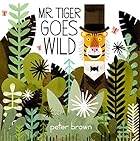 Mr. Tiger Goes Wild by Peter Brown -- in a staid Edwardian society, one tiger gets fed up with good manners and proper clothing, and he goes completely wild. This is another picture book that brings the funny, and I must admit that I guffawed at the full spread of Mr. Tiger, newly nude and obviously proud of it! The color palette really works well, with the lush greens of the forest contrasting with the tans and browns of the city, and Mr. Tiger showing up as a bright pop of color in each.
Mr. Tiger Goes Wild by Peter Brown -- in a staid Edwardian society, one tiger gets fed up with good manners and proper clothing, and he goes completely wild. This is another picture book that brings the funny, and I must admit that I guffawed at the full spread of Mr. Tiger, newly nude and obviously proud of it! The color palette really works well, with the lush greens of the forest contrasting with the tans and browns of the city, and Mr. Tiger showing up as a bright pop of color in each.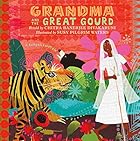 Grandma and the Great Gourd by Chitra Banerjee Divakaruni, illustrated by Susy Pilgrim Waters -- this is my dark horse pick, as I've heard very little about it around the various blogs I frequent, which is a shame. In this traditional folktale, Grandma goes through the forest to visit her daughter. Three predatory animals consider eating her, but she convinces them to wait until she comes back through, as eating her daughter's good cooking will fatten her up. She finds a creative solution to get her back through the forest when it is time to go home, but will it trick the hungry beasts? As you can see from the cover, this book is full of vibrant, saturated colors. The backgrounds remind me of batik cloth, providing an excellent foil for Grandma in her flowing white dress.
Grandma and the Great Gourd by Chitra Banerjee Divakaruni, illustrated by Susy Pilgrim Waters -- this is my dark horse pick, as I've heard very little about it around the various blogs I frequent, which is a shame. In this traditional folktale, Grandma goes through the forest to visit her daughter. Three predatory animals consider eating her, but she convinces them to wait until she comes back through, as eating her daughter's good cooking will fatten her up. She finds a creative solution to get her back through the forest when it is time to go home, but will it trick the hungry beasts? As you can see from the cover, this book is full of vibrant, saturated colors. The backgrounds remind me of batik cloth, providing an excellent foil for Grandma in her flowing white dress. Journey by Aaron Becker -- This one, on the other hand, seems to be a crowd favorite. A lonely little girl with a red marker draws a door and walks through it into a fantastical country where she has amazing adventures, and meets a new friend, as well. Publishers are always pitching things as "this meets that," so I'd call this Harold and the Purple Crayon meets David Macaulay -- the story is reminiscent of the former, but the artwork displays the meticulous attention to detail of the latter.
Journey by Aaron Becker -- This one, on the other hand, seems to be a crowd favorite. A lonely little girl with a red marker draws a door and walks through it into a fantastical country where she has amazing adventures, and meets a new friend, as well. Publishers are always pitching things as "this meets that," so I'd call this Harold and the Purple Crayon meets David Macaulay -- the story is reminiscent of the former, but the artwork displays the meticulous attention to detail of the latter. Building Our House by Jonathan Bean -- the most personal of my choices, since my parents are in the very beginning stages of building a retirement home on my grandparents' farm. This book has something for everyone: technical details, tools, and equipment for readers who love diggers and dumpers, little details of family life and changes for those more interested in the human side of the story, and even an entire wordless story about a cat and her kittens, for the cat lovers willing to take a closer look. It's not as showy a title as some of the others I've mentioned, or even some of the others I haven't mentioned, but it definitely has its quiet charms.
Building Our House by Jonathan Bean -- the most personal of my choices, since my parents are in the very beginning stages of building a retirement home on my grandparents' farm. This book has something for everyone: technical details, tools, and equipment for readers who love diggers and dumpers, little details of family life and changes for those more interested in the human side of the story, and even an entire wordless story about a cat and her kittens, for the cat lovers willing to take a closer look. It's not as showy a title as some of the others I've mentioned, or even some of the others I haven't mentioned, but it definitely has its quiet charms.
I could easily go on and list several honorable mention titles, but I'll stop there. Over the next few days, I'll be posting favorites from juvenile and young adult fiction, so be on the lookout!
Friday, January 10, 2014
Harry Potter and the Sorcerer's Stone by J.K. Rowling
Harry Potter and the Sorcerer's Stone by J. K. Rowling hardly needs another review written, but I'll go ahead and make notes of my thoughts on this reread. Warning: I'm including spoilers for the entire series, so if you have not yet read it but intend to do so, you may want to skip these ruminations.
I've read this book many times, and it stands up well to rereading. This time through, I was amazed to discover that there are two things that I like better in the movie than in the book. Shocking, no? The "She needs to sort out her priorities" line is sheer brilliance, and you won't find it in the book. Also, in the scene where Harry, Ron, and Hermione take on the troll in the bathroom, book-Hermione spends the scene nearly fainting in fright, while movie-Hermione gets to call out instructions to Ron, giving her a slightly more active role in that scene.
In previous rereads, I have been struck by the illogical nature of the protections set on the Stone at Hogwarts. Why "protect" the stone with a series of enchantments that can be overcome by first-year Hogwarts students? Isn't there any more powerful magic that could be employed? On this reread, I started to wonder if perhaps the stone and Harry were bait for Voldemort; if Dumbledore set up the whole thing to draw Voldemort back out of hiding, now that Harry was ready to be a player again. (Harry says something like this at the end of the book, when discussing events with Ron and Hermione.) Kind of ruthless of Dumbledore, but as Snape accuses him in a later scene, he does have a ruthless side when it comes to Harry, especially at this point, where Dumbledore has not really gotten to know Harry yet. I think this same ruthlessness comes into play when addressing another big question about the book: why leave Harry with his borderline abusive relatives and never check up on him? If Dumbledore was periodically visiting or sending scouts to a particular Muggle residence, it would have been easier for Death Eaters to discover where the boy was hidden, and attack him before he was old enough to have had any magical training. After all, the protection afforded by the blood bond would keep him safe from Voldemort, but not from, say, Lucius Malfoy or Barty Crouch, Jr.
I still count Dumbledore as one of my favorite characters (right up there with Snape), but from this angle he does look a little cold and calculating.
This book is not my favorite of the series, but it's in my top three, at least partly because of the way it draws readers in to the magical world. Who wouldn't want to shop in Diagon Alley and attend classes at Hogwarts after reading the descriptions of Harry's adventures? I remember getting this book, back before the media hoopla, and reading it through two times in a row and then handing it off to the rest of the family and insisting that they read it. I took my time to savor it on this read-through, and plan to do the same with the rest of the books, spacing them out one per month.
(Reviewed from my personally purchased copy.)
Thursday, January 9, 2014
The Dolphins of Shark Bay by Pamela Turner
The Dolphins of Shark Bay by Pamela S. Turner is another entry in the excellent Scientists in the Field series.
In a remote part of the Australian coast, scientists observe a tribe of local dolphins who have developed some unusual, and impressive, skills. Some use sponges as tools, holding them in their mouths and using them to startle bottom-dwelling fish off the bay's rocky floor. Others chase fish onto the beaches and catch them, managing to leave and return to the water. One brave female goes after much larger prey than the others, preferring to eat one large meal instead of several small ones. These skills seem to be passed down from mother to child. Why have the dolphins learned these skills? What else might they be capable of?
This book was a lot of fun to read, with a relatively informal narrative style and a bit of humor thrown in occasionally. The author tells the story of Janet Mann, a scientist who has devoted her career to studying the Shark Bay dolphins. She also tells the stories of the dolphins themselves, explaining their complex social structures and their various hunting styles. There's a little bit of anthropomorphizing, through the author tries to avoid it, but who among us could resist the temptation to describe dolphin interactions in human terms? (Considering the amount of times I have put words in my dog's mouth, not me!) This book is sure to charm all dolphin-loving readers.
(Reviewed from a copy borrowed through my library system.)
In a remote part of the Australian coast, scientists observe a tribe of local dolphins who have developed some unusual, and impressive, skills. Some use sponges as tools, holding them in their mouths and using them to startle bottom-dwelling fish off the bay's rocky floor. Others chase fish onto the beaches and catch them, managing to leave and return to the water. One brave female goes after much larger prey than the others, preferring to eat one large meal instead of several small ones. These skills seem to be passed down from mother to child. Why have the dolphins learned these skills? What else might they be capable of?
This book was a lot of fun to read, with a relatively informal narrative style and a bit of humor thrown in occasionally. The author tells the story of Janet Mann, a scientist who has devoted her career to studying the Shark Bay dolphins. She also tells the stories of the dolphins themselves, explaining their complex social structures and their various hunting styles. There's a little bit of anthropomorphizing, through the author tries to avoid it, but who among us could resist the temptation to describe dolphin interactions in human terms? (Considering the amount of times I have put words in my dog's mouth, not me!) This book is sure to charm all dolphin-loving readers.
(Reviewed from a copy borrowed through my library system.)
Sunday, January 5, 2014
Out of the Easy by Ruta Sepetys
Out of the Easy by Ruta Sepetys is another LibraryThing Early Reviewer book that I'm belatedly reviewing.
Josie Moraine is sharp, independent, and well-read. She's also the daughter of a French Quarter prostitute, and she feels that, as long as she lives in New Orleans, that's all that people will see. Josie's fondest wish is to go to college, preferably somewhere far away from the Big Easy, but it's not so easy to leave. Josie is saving every penny she can while working two jobs, but it will take years to earn enough to pay tuition to Smith, her dream school. And she can't ask her mother for help, considering that her mother is more likely to steal Josie's savings than to chip in money for college. Josie doesn't know who her father was, but she likes to imagine that he was someone good and kind, someone like Forrest Hearne, a gentleman from out of state who stops by the bookstore on New Years Eve, 1949, and speaks kindly to Josie about Dickens and Keats. Even in a brief exchange, Hearne makes Josie feel interesting, as if he sees her as someone with potential. But a few hours later, Hearne is dead -- and the next morning, while cleaning the brothel where her mother works, Josie discovers Forrest Hearne's watch under her mother's bed. Josie finds herself caught up in the murder investigation, first through her own curiosity, and later through her mother's involvement. She's also caught up in the drama of applying to Smith, fighting for a space among a crowd of applicants with more extracurricular activities and better references. To top it off, she's caught between two potential suitors, one who holds the comfort of long friendship, while the other is exciting and charming. Will she choose the former, the latter, or neither? After all, what she wants most isn't a man, but a ticket out of the Easy.
This is one of those books I can't believe I waited this long to read. The characters are layered and complex, and Josie is likeable, but also believable -- sharp, salty, and strong. She's the sort of character that you root for, but she's also a little unpredictable, so you never quite know how the story will turn out. The secondary characters are likewise well-written. I wanted a bit more from the mystery aspect of the plot, and the New Orleans atmosphere was a little diluted, but those are small criticisms when stacked against all of the goodness of the characters and writing. I definitely recommend this one.
(Reviewed from an advance copy, courtesy of the publisher, via the LibraryThing Early Reviewers program.)
Josie Moraine is sharp, independent, and well-read. She's also the daughter of a French Quarter prostitute, and she feels that, as long as she lives in New Orleans, that's all that people will see. Josie's fondest wish is to go to college, preferably somewhere far away from the Big Easy, but it's not so easy to leave. Josie is saving every penny she can while working two jobs, but it will take years to earn enough to pay tuition to Smith, her dream school. And she can't ask her mother for help, considering that her mother is more likely to steal Josie's savings than to chip in money for college. Josie doesn't know who her father was, but she likes to imagine that he was someone good and kind, someone like Forrest Hearne, a gentleman from out of state who stops by the bookstore on New Years Eve, 1949, and speaks kindly to Josie about Dickens and Keats. Even in a brief exchange, Hearne makes Josie feel interesting, as if he sees her as someone with potential. But a few hours later, Hearne is dead -- and the next morning, while cleaning the brothel where her mother works, Josie discovers Forrest Hearne's watch under her mother's bed. Josie finds herself caught up in the murder investigation, first through her own curiosity, and later through her mother's involvement. She's also caught up in the drama of applying to Smith, fighting for a space among a crowd of applicants with more extracurricular activities and better references. To top it off, she's caught between two potential suitors, one who holds the comfort of long friendship, while the other is exciting and charming. Will she choose the former, the latter, or neither? After all, what she wants most isn't a man, but a ticket out of the Easy.
This is one of those books I can't believe I waited this long to read. The characters are layered and complex, and Josie is likeable, but also believable -- sharp, salty, and strong. She's the sort of character that you root for, but she's also a little unpredictable, so you never quite know how the story will turn out. The secondary characters are likewise well-written. I wanted a bit more from the mystery aspect of the plot, and the New Orleans atmosphere was a little diluted, but those are small criticisms when stacked against all of the goodness of the characters and writing. I definitely recommend this one.
(Reviewed from an advance copy, courtesy of the publisher, via the LibraryThing Early Reviewers program.)
Jane, the Fox, and Me by Fanny Britt
Jane, the Fox, and Me by Fanny Britt, illustrated by Isabelle Arsenault, is a graphic novel recommended by a friend.
Helene is feeling insecure: the girls she used to be friends with have suddenly turned on her, whispering behind her back and writing nasty comments on the bathroom wall. To escape, she reads Jane Eyre, which she has decided is the best book ever, even though she is only part of the way through it. But what will happen when her entire class, including her tormentors, is sent off to nature camp for a week?
This is a quick read, even for a graphic novel. The artwork is done in a style that doesn't particularly appeal to me -- it looks half-finished. (But I am an uncultured barbarian when it comes to graphic novels, so don't mind me.) Helene is a great character, and in just a few interactions we get a real sense of her relationship with her mother as well as the general climate at school. I think this will resonate with kids who, like Helene, are being bullied, but I can't see them picking it up on their own. This is a book in need of champions to see that it gets into the hands of the readers who need it.
(Reviewed from a copy borrowed through my library system.)
Helene is feeling insecure: the girls she used to be friends with have suddenly turned on her, whispering behind her back and writing nasty comments on the bathroom wall. To escape, she reads Jane Eyre, which she has decided is the best book ever, even though she is only part of the way through it. But what will happen when her entire class, including her tormentors, is sent off to nature camp for a week?
This is a quick read, even for a graphic novel. The artwork is done in a style that doesn't particularly appeal to me -- it looks half-finished. (But I am an uncultured barbarian when it comes to graphic novels, so don't mind me.) Helene is a great character, and in just a few interactions we get a real sense of her relationship with her mother as well as the general climate at school. I think this will resonate with kids who, like Helene, are being bullied, but I can't see them picking it up on their own. This is a book in need of champions to see that it gets into the hands of the readers who need it.
(Reviewed from a copy borrowed through my library system.)
Saturday, January 4, 2014
Sorrow's Knot by Erin Bow
Sorrow's Knot by Erin Bow is my first book of the new year.
Otter's mother Willow is a binder -- a woman who can tie powerful knots to keep away the hungry dead. Otter believes that she will someday become a binder, too -- until Tamarak, the old binder, dies. But on the day of Tamarak's death, Willow goes a little crazy. She pushes Otter out of the binder's lodge, claiming that she will never take Otter as an apprentice. Willow says that something is wrong with the knots. And then Willow does something else, something worse. . . .
I'm having a hard time summarizing this one, probably because it's a fairly complex concept. The setting has a sort of Native American feel, though the author doesn't identify Otter's people with any particular tribe, or even any easily recognizable location. There are creatures that are not quite ghosts and not quite zombies. It's quite different from anything I've read, including the author's earlier book, and it's very dark. Very, very dark. Unrelentingly dark. I am amazed it didn't give me nightmares. But the writing is very good, and I'm glad to have read it (though it's not a book I see myself ever rereading). If you like dark fantasy, bordering on horror, but written with a literary tone, I'd recommend this.
(Reviewed from a copy borrowed through my library system.)
Otter's mother Willow is a binder -- a woman who can tie powerful knots to keep away the hungry dead. Otter believes that she will someday become a binder, too -- until Tamarak, the old binder, dies. But on the day of Tamarak's death, Willow goes a little crazy. She pushes Otter out of the binder's lodge, claiming that she will never take Otter as an apprentice. Willow says that something is wrong with the knots. And then Willow does something else, something worse. . . .
I'm having a hard time summarizing this one, probably because it's a fairly complex concept. The setting has a sort of Native American feel, though the author doesn't identify Otter's people with any particular tribe, or even any easily recognizable location. There are creatures that are not quite ghosts and not quite zombies. It's quite different from anything I've read, including the author's earlier book, and it's very dark. Very, very dark. Unrelentingly dark. I am amazed it didn't give me nightmares. But the writing is very good, and I'm glad to have read it (though it's not a book I see myself ever rereading). If you like dark fantasy, bordering on horror, but written with a literary tone, I'd recommend this.
(Reviewed from a copy borrowed through my library system.)
Labels:
adventure,
fantasy,
horror,
paranormal,
young adult
Subscribe to:
Posts (Atom)
